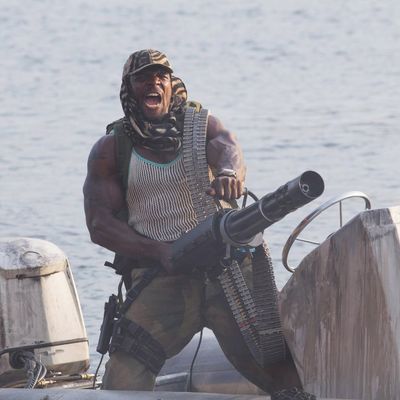
It’s sad to watch a tough guy go soft, but that’s the case with this weekend’s The Expendables 3, in which Sylvester Stallone neuters his own geriatric-badass franchise by ditching the previous two installments’ R-rated bloodshed for PG-13 warfare. The reason for Stallone’s decision isn’t difficult to decipher — a PG-13 rating will make the film accessible to its largest potential audience. While that logic is often sound (just ask Marvel or Michael Bay), in this instance, it seems faulty, since teens are unlikely to care about these older-era stars reuniting for some ‘80s-style mayhem, and adults who do care about the gang getting back together again are apt to be disappointed by this go-round’s less violent craziness. By this point, it’s pretty clear that PG-13 has ruined the mainstream American action movie.
Can you point to any decent action in a recent big-budget American movie? Action that isn’t edited to ribbons so that it looks like a bunch of fuzzy arms and legs flying across the screen in a spasmodic flurry of movement? To endure what passes for a mainstream action film today is to be subjected to clumsily paced, spatially illogical, laughably bloodless visual gibberish, all of it scored to loud noises and forceful grunts that help denote when a punch is being landed or a body is smashing into something — audio clues that are necessary to help make heads or tails of the mess being smeared across the screen.
This style of deliberately unintelligible action moviemaking has come to be known as “Chaos Cinema,” and has been pioneered over the past 20 years by Michael Bay and his disciples. While Chaos Cinema is the byproduct of numerous forces (as I’ve previously written about), its advancement is also the direct consequence of a culture that wants its action at once intense enough to be “awesome” and yet toothless enough to be deemed acceptable for adolescents by the violence-lenient MPAA. This is what has bred The Expendables 3, which delivers an endless stream of fisticuffs, gunfights, and vehicular clashes and stunts that involve the deaths of hundreds of faceless villains, but never once shows a graphic kill-shot, or depicts a trace of real blood or any genuine human suffering, or even presents a lucid view of who’s doing what to whom at any given moment.
Thus, The Expendables 3 features its collection of aged heroes (Stallone, Wesley Snipes, Arnold Schwarzenegger, Harrison Ford, Antonio Banderas, Mel Gibson, Dolph Lundgren, etc.) and whippersnapper accomplices (Jason Statham, Kellan Lutz, MMA fighter turned actress Ronda Rousey) breaking necks, stabbing chests, slicing throats, and slaughtering bad guys in all sorts of other gruesome ways. In each instance, though, the camera, determined to mitigate its presentation of this patently ultraviolent material, moves so fast and cuts from one image to another so quickly that we don’t get a clear idea of what’s happening. Instead, we get merely the impression of a fight, or a death. It’s a show-but-don’t-really-show method of approaching violence that leads to visual incoherence — one that’s found in even the year’s finest blockbusters (Guardians of the Galaxy, Captain America: The Winter Soldier, Edge of Tomorrow), whose presentation of combat is now routinely their weakest element.
In this PG-13–dominated landscape, R-rated counterpoints are both rare and conspicuous. Take June’s Snowpiercer, whose centerpiece battle pitting Chris Evans and his rebel forces against an army of hooded, ax-wielding maniacs utilizes slow-motion and long, unbroken shots to emphasize movement and increase thrills. Or last month’s Lucy, which forgoes hyperactive editing in favor of sharp, dynamic cuts that boost its signature sights of Scarlett Johansson supernaturally dispatching adversaries. Or The Raid 2, the sequel to 2011’s cult Thai hit, which uses amazingly extended takes and dancerlike cinematography to create its breakneck momentum, limb-shattering forcefulness, and — most of all — its fluid visual clarity. Even if one objects to the extreme nastiness of The Raid 2, there’s no arguing that you can actually see what’s going on throughout its frenzied skirmishes, and that such intelligibility augments the excitement that the action is supposed to result in.
The best recent contrast to The Expendables 3’s herky-jerky faux action is this past March’s 300: Rise of an Empire. Taking its stylistic cues from Zach Snyder’s 2007 predecessor, Noam Murro’s saga is one lavishly vicious setpiece after another, all of them boasting Snyder’s trademark “speed-ramping” technique, in which the material fluctuates between slow-motion and fast-forward to precisely elucidate what’s occurring, and then to give added punchiness to key incidents or fatal blows. The film climaxes with a final battle marked by a lengthy continuous tracking shot alongside hero Themistocles (Sullivan Stapleton) as he slays hordes of enemies, a sequence that — from its camerawork to its sets to its blood to its characters themselves — is practically dripping with outlandish 3-D CG effects. Yet unlike so many of its genre brethren, 300: Rise of an Empire employs its digital embellishments not to gussy up incoherent visuals, but rather to enhance them by providing a well-structured, aesthetically articulate sense of who’s who and what’s taking place.
That clear, precise presentation of brutality in turn gives Rise of an Empire’s action the very type of visceral power that’s negated as soon as filmmakers chop their fights and shootouts to pieces in order to earn a PG-13 rating. As evidenced by Rocky and Rambo and Cobra and Cliffhanger (to name just a few!), Stallone once understood this. If he hopes to continue bringing back old-school action through throwback projects like The Expendables 3, he’d be wise to remember it again.

